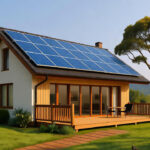Welcome back to The Net Zero Guy. We’re all about making sustainable living practical and doable, without overwhelming you with jargon or impossible goals. Today, we’re diving deep into our Net Zero Living Guide showcasing a roadmap to cutting your carbon footprint to zero while still enjoying life. Whether you’re just starting out or looking to level up, this post breaks it down step by step. We’ll cover everything from home energy tweaks to smarter food choices, drawing from real tips and examples. Let’s get into it and see how small changes can add up to big impact.
What Does Net Zero Living Really Mean?
First things first: net zero means balancing the greenhouse gases you produce with what you remove from the atmosphere. It’s not about being perfect overnight; it’s about offsetting emissions through efficiency, renewables, and mindful habits. For individuals, this translates to a lifestyle where your daily actions like heating your home or commuting don’t add net carbon to the planet. According to experts, aiming for net zero by 2050 is crucial to limit global warming. At The Net Zero Guy, we see it as empowering: you control more than you think. Start by tracking your emissions with free tools like the EPA’s carbon calculator, then build from there. It’s achievable, and we’ll show you how in the sections below.
Optimizing Energy Use at Home
Your home is often the biggest source of emissions, but it’s also where you can make the quickest wins. Switching to renewable energy is key. Just think about solar panels or signing up with providers like Good Energy for 100% green tariffs. If installing panels isn’t feasible, start small: upgrade to LED bulbs, which use 75% less energy than incandescents, and smart thermostats like Nest to automate heating. We’ve seen folks cut bills by 10-20% just by sealing drafts and adding insulation.

Invest in Energy Star appliances; brands like Bosch make efficient fridges that last longer and sip power. For heating, consider heat pumps. They’re three times more efficient than gas boilers. If you’re renting, focus on habits: unplug devices to avoid phantom energy (it adds up to 10% of your bill), and wash clothes in cold water. Remember, every kilowatt saved is emissions avoided. Pair this with community solar programs if available in your area as they let you go green without rooftop panels.
Don’t overlook passive design: orient windows for natural light, plant shade trees, or use reflective roofs to stay cool without AC. Studies show these tweaks can reduce energy needs by 30%. It’s not just eco, it’s wallet-friendly too. Over time, these changes pay for themselves, turning your home into a net zero haven.
Choosing Eco-Friendly Transportation
Transportation accounts for about 29% of global emissions, so rethinking how you get around is huge. The goal? Shift from fossil fuels to low-carbon options. If you drive, electric vehicles (EVs) like Tesla’s Model 3 cut emissions by half compared to gas cars, especially if charged with renewables. But you don’t need to buy new as hybrid models from Toyota are a solid bridge.

For shorter trips, biking or walking is unbeatable ie. zero emissions and good for health. E-bikes from brands like Rad Power make hills easier and extend your range. Public transit shines here: buses and trains emit far less per passenger than solo driving. Apps like Citymapper help plan efficient routes. If flying is unavoidable, offset with credible programs like those from Gold Standard. We encourage carpooling via BlaBlaCar or remote work to slash commutes. One practical tip: maintain tire pressure for better fuel efficiency, it’s a free win. Over a year, combining these can reduce your transport footprint by 50%.
Sustainable Food Choices and Zero Waste Kitchen
Food systems contribute up to 37% of emissions, from farming to waste. Adopting a plant-based or flexitarian diet is transformative. Eat more veggies, grains, and legumes to cut methane from livestock. Brands like Beyond Meat offer tasty alternatives without the environmental hit.

Shop local and seasonal to minimize transport emissions; farmers’ markets are great for this. Go zero waste by using reusable bags, buying in bulk from stores like Whole Foods, and composting scraps. Apps like Too Good To Go rescue surplus food. Reduce packaging: choose loose produce over wrapped, and cook from scratch to avoid processed items. Leftover veggie peels? Make stock. Meal planning prevents waste, and freezing portions extends freshness. We’ve found that eating less meat one day a week can save the equivalent of driving 1,000 fewer miles annually.
Hydration matters too. Ditch plastic bottles for a reusable Hydro Flask, and filter tap water. Overall, these habits not only lower emissions but boost nutrition and save money.
Reducing Waste and Consumption
Waste is a silent emitter and landfills produce methane, and production guzzles resources. The three Rs: reduce, reuse, recycle. Start by auditing your trash; you’ll spot easy cuts like switching to cloth napkins or bamboo toothbrushes from brands like Humble Brush.

For shopping, opt for quality over quantity. Patagonia’s durable gear lasts for years. Thrift via Depop or repair items instead of tossing them. In electronics, choose refurbished from Apple or extend life with updates. Compost organics to divert 50% of household waste from landfills. We love community swaps for clothes and tools. Digital detox: delete unused emails (they have a carbon cost) and go paperless. These steps foster a circular mindset, where nothing’s truly wasted.
Tying It Back to Clothing and Daily Habits
Building on our recent post about fast fashion, apply net zero to your wardrobe: rewear, layer, and thrift. Brands like Everlane use sustainable materials. Extend this to all consumption question needs vs. wants, and support ethical companies. Track progress with apps like Joule for emissions logging.
Making It Stick: Community and Long-Term Wins
Net zero isn’t solo, join local groups or online forums for support. Governments offer incentives like rebates for EVs or insulation. Track savings: many see 20-30% lower bills. It’s rewarding: cleaner air, health benefits, and knowing you’re part of the solution.
In wrapping up, this guide is your starting point. Pick one area, like energy or food, and build from there. At The Net Zero Guy, we’re here with resources to help. Share your progress and we’d love to feature community stories. Together, net zero is within reach.










